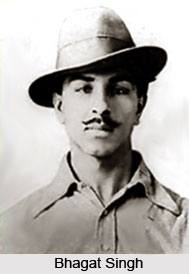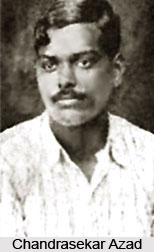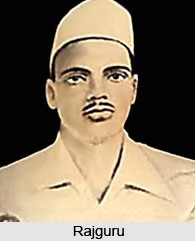 Hindustan Socialist Republican Association before 1928 was known as the Hindustan Republican Association. It is reckoned as one amongst the Indian independence associations during the time of freedom struggle. Bhagat Singh, Yogendra Shukla and Chandrasekar Azad were the key functionaries of Hindustan Socialist Republican Association. The group is also considered one of the first socialist organisations in India. HSRA was invigorated by the ideologies of the Bolsheviks involvement in the Russian Revolution of 1917.
Hindustan Socialist Republican Association before 1928 was known as the Hindustan Republican Association. It is reckoned as one amongst the Indian independence associations during the time of freedom struggle. Bhagat Singh, Yogendra Shukla and Chandrasekar Azad were the key functionaries of Hindustan Socialist Republican Association. The group is also considered one of the first socialist organisations in India. HSRA was invigorated by the ideologies of the Bolsheviks involvement in the Russian Revolution of 1917.
Hindustan Socialist Republican Association was first launched during a meeting in Bholachang village, Brahamabaria subdivision, East Bengal. Praiseworthy freedom fighters like- Pratul Ganguly, Narendra Mohan Sen and Sachindra Nath Sanyal were present at the meeting. The association was formed as an outgrowth of the Anushilan Samiti. The party was established with the aim to organise armed revolution in order to end the colonial rule and establish a Federal Republic of the United States of India. The name Hindustan Socialist Republican Association was implicative after a similar revolutionary body in Ireland.
During that period Gandhiji had declared to cancel the Non-cooperation movement after the Chauri Chaura incident. This decision of his created a lot of rancour amongst the youngsters. Some of them had jeopardised their careers for the movement. As HSRA was a revolutionary group, they attempted to loot a train. They were informed that the train was transferring government money. On 9th August 1925, the revolutionists ransacked the train. This now famous incident is known as the Kakori train robbery. As a result of the Kakori train robbery case, Ashfaqullah Khan, Ramprasad Bismil, Roshan Singh, Rajendra Lahiri were hanged to death. It was an important setback for the Hindustan Socialist Republican Association.
Hindustan Socialist Republican Association was aiming to create a Federal Republic of the United States of India. But later they changed their focus towards creating an India based on the Socialist ideals of Lenin and Marx. Bhagat Singh declared this at the Ferozshah Kotla Ruins in Delhi on September 9th,1928. Afterwards, the association was renamed Hindustan Socialist Republican Association, from Hindustan Republican Association. HSRA in a non-violent protest advancement against the Simon Commission at Lahore decided to support Lala Lajpat Rai. But in the protest procession, the police plunged into a mass lathi-charge and the wounds imposed on Lalaji proved life-threatening to him. This incident was witnessed by Bhagat Singh and he swore to take revenge.
 It was decided by Hindustan Socialist Republican Association that the attempt would be taken against J A Scott, who had ordered the unlawful lathi-charge. Bhagat Singh, Rajguru, Chander Shekhar Azad and Jai Gopal were given the charge to execute the plan. It was designed that Jai Gopal would signal Bhagat Singh and Rajguru when J A Scott would come out of his office. At the appointed time, on 17th December 1928 at Lahore, a British official J. P. Saunders, the A.S.P., a youngman of 21 but a probationer stepped out of his office. Raj Guru swooped on the British official with a pistol at Jai Gopal`s signal. The bullet perforated through his neck and almost killed him. Bhagat Singh also rushed and pounced on him and fired four or five shots. J. P. Saunders died on the spot.
It was decided by Hindustan Socialist Republican Association that the attempt would be taken against J A Scott, who had ordered the unlawful lathi-charge. Bhagat Singh, Rajguru, Chander Shekhar Azad and Jai Gopal were given the charge to execute the plan. It was designed that Jai Gopal would signal Bhagat Singh and Rajguru when J A Scott would come out of his office. At the appointed time, on 17th December 1928 at Lahore, a British official J. P. Saunders, the A.S.P., a youngman of 21 but a probationer stepped out of his office. Raj Guru swooped on the British official with a pistol at Jai Gopal`s signal. The bullet perforated through his neck and almost killed him. Bhagat Singh also rushed and pounced on him and fired four or five shots. J. P. Saunders died on the spot.
Incidentally it was a terrible miscalculation on the part of Jai Gopal. He failed to differentiate between Scott and Saunders. Chanan Singh- a head constable came forth to chase Bhagat Singh and Raj Guru, but Chandra Shekhar Azad shot Chanan down. The next day, Hindustan Socialist Republican Association came forward in public and in their proclamation said, "Inquilab Zindabad (Long Live Revolution). We don`t enjoy killing an individual, but this individual was ruthless, mean and part and parcel of an unjust system. It is necessary to destroy such a system. This man has been killed, because he was a cog in the wheel of British rule. This government is the worst of all governments."
Another significant action carried out by the Hindustan Socialist Republican Association was the Assembly Bomb Case. The association adjudicated to burst a blank bomb in the Central Assembly in Delhi, in order to express opposition against the tyrannical legislation and arouse public opinion. Bhagat Singh and Batukeshwar Dutt offered to carry out the bombing and get arrested. The ideology behind the bombing was `to make the deaf government hear the voices of its oppressed people`. Bhagat Singh also believed that `the only way to successfully convey his message to the public of India was to propaganda from Court`. He believed that since all statements were registered in Court and then promulgated, they could benefit support for their crusade.
On April 8th 1929 when Vitthal Bhai Patel, President of the Central Assembly, moved up to give his ruling on failing to get an authority from the government that the bill would not be imposed retrospectively, a bomb was detonated near the empty treasure benches, followed by another bomb explosion. Panic predominated everywhere. Nobody got killed as it was not thought of. The hall got filled with smoke. Bhagat Singh and BK Dutt started crying out "Long Live Revolution, Down with Imperialism" as the smoke cleared. They also threw red leaflets on the floor, which began with the slogan of a French revolutionary "It needs a loud voice for a deaf to hear".
On April 15th 1929, police raided the bomb factory of HSRA. As a result Kishori Lal, Sukhdev and Jai Gopal were arrested. The Assembly Bomb Case trial was started following this raid. On 23rd March 1931 Bhagat Singh, Sukhdev and Rajguru were hanged. The great nationalist Baikuntha Shukla was also hanged for murdering Phanindrananth Ghosh who had become a government approver which later on led to the hanging of Bhagat Singh, Sukhdev and Rajguru. Baikuntha Shukla joined the freedom struggle at a young age and took active part in the `Salt Satyagraha` of 1930. He was also associated with revolutionary organisations like the Hindustan Seva Dal and Hindustan Socialist Republican Association.
 Bhagat Singh, Rajguru and Sukhdev were executed in 1931, as a result of their trial in the `Lahore conspiracy case`. Their death penalty gave birth to tremendous agitation throughout the country. Phanindrananth Ghosh was a key figure of the Hindustan Socialist Republican Association. By turning into an approver, he betrayed the cause of the party. Baikuntha Shukla was given the charge to execute Phanindrananth Ghosh as an act of ideological revenge. He completed it in a successful manner on 9th November 1932. As a result Baikuntha Shukla was arrested and tried for murder. On May 14th 1934, Baikunth was convicted and hanged in Gaya Central Jail only at a young age of 28.
Bhagat Singh, Rajguru and Sukhdev were executed in 1931, as a result of their trial in the `Lahore conspiracy case`. Their death penalty gave birth to tremendous agitation throughout the country. Phanindrananth Ghosh was a key figure of the Hindustan Socialist Republican Association. By turning into an approver, he betrayed the cause of the party. Baikuntha Shukla was given the charge to execute Phanindrananth Ghosh as an act of ideological revenge. He completed it in a successful manner on 9th November 1932. As a result Baikuntha Shukla was arrested and tried for murder. On May 14th 1934, Baikunth was convicted and hanged in Gaya Central Jail only at a young age of 28.
Another key revolutionary of Hindustan Socialist Republican Association, Chandrasekar Azad was killed on 27th February 1931 in a gunfight with the police. With the death of Chandrashekar Azad and the hanging of its popular activists, Bhagat Singh, Sukhdev and Rajguru, the fate of the association was yet indecipherable. Hindustan Socialist Republican Association was always in the forefront of revolutionary movements in the northern parts of India. The association consisted of younger generations of U.P, Bihar, Punjab, Bengal and Maharashtra. The group possessed ideals, which were directly opposite to Mahatma Gandhi`s Congress.



















